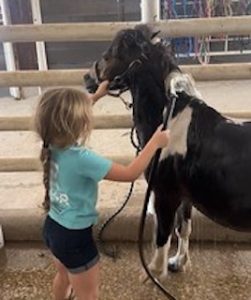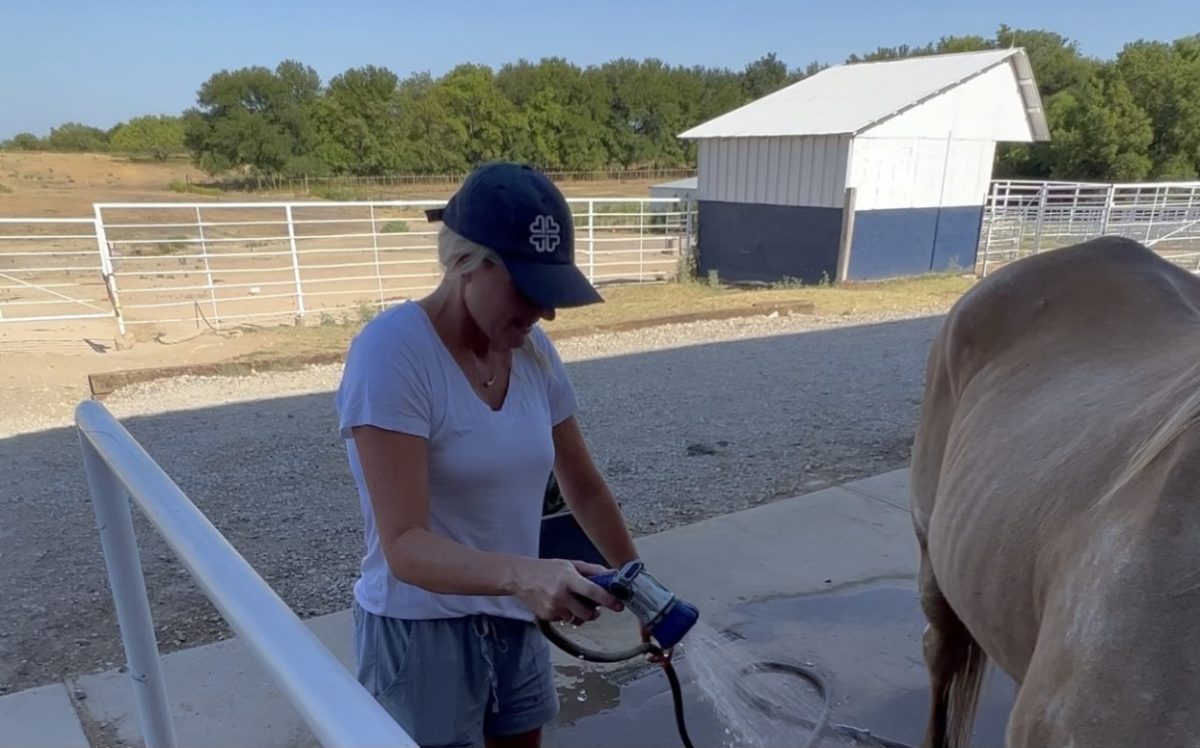Making a “barn sweep” is a thing I do regularly around here at 4Hearts Ranch. (No, it doesn’t involve a broom or blower!) These slow, deliberate daily tours of all three of our barns allow my eyes to sweep across the horses, facilities, equipment—whatever is in my path—for anything amiss. And I’ve been especially vigilant for any signs of heat stress, colic, or other byproducts of this scorching and humid Texas summer.
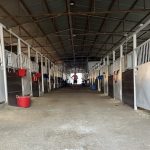 Because at 4Hearts we have night turnout to give our horses a break from the sun and flies, our horses being inside under fans during the day is a great way to keep a close eye on how everyone is doing with the heat.
Because at 4Hearts we have night turnout to give our horses a break from the sun and flies, our horses being inside under fans during the day is a great way to keep a close eye on how everyone is doing with the heat.
So last week, my sweep turned up a mare breathing fast, not sweating, and looking uncomfortable. Anhidrosis was my first thought. Anhidrosis is scary because it means a horse has lost the ability to sweat, and sweat is what helps a horse cool down. If they can’t cool themselves off by sweating, they could have a heat stroke, which could be fatal. Other horses suffering from excess heat may not have the anhidrosis issue, but it can trigger colic if they’re not drinking as much as their body needs.
I knew I needed to get the mare’s body temp down, call the vet, and contact her owner, who was out of town. The owner responded immediately to tell me that her horse was diagnosed with anhidrosis years earlier when they lived in Houston. (Given our decidedly Houston-like climate this year in Fort Worth, Texas, this made sense!) Dr. Grady Cofield, one of the vets who regularly comes to 4Hearts from Weatherford Equine, told me what to do. (A quick note from Dr. C here is it’s essential to get professional help with this diagnosis — all sorts of underlying medical issues need to be considered and ruled out before treating a horse for anhidrosis.)
So, this experience got me thinking. With so many horses struggling with the extreme heat (with or without anhidrosis) and so many horse owners wondering what they need to be doing to help, what danger signs to look for — and what to do when they see them — I wanted to share some “hot horse tips” from 4Hearts Ranch!
If you suspect your horse isn’t sweating (or isn’t sweating as much), the first thing to do is check their temperature rectally with a regular digital thermometer. If the temp is over 102, the next thing to do is get the horse cooled down as quickly as possible with a cool-water rinse and put them under a fan.
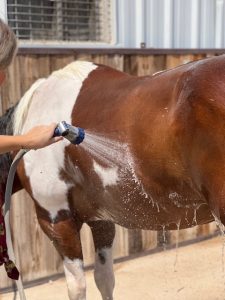
To increase the evaporative cooling effect of the cool water rinse, Dr. C. also recommends pouring 70% isopropyl alcohol down the length of the spine. (You can do this as often as once or twice a day following the all-over rinse.)
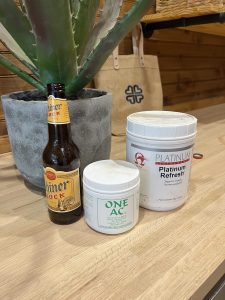
Because this horse was previously diagnosed with anhidrosis, Dr. C recommended a regimen of dark beer (yep, you read that right) once a day for 4-5 days, a scoop twice a day of Platinum Refresh®, and a scoop twice a day of One AC. He said that because some horses respond better to one of these electrolytes better than the other, and some respond best to the combination, he likes to start with all three things, combined with the twice daily rinse and alcohol drizzle.
While it is essential to get a diagnosis before treating your horse for anhidrosis, the following remedies can be helpful for any horse struggling with the effects of extreme heat:
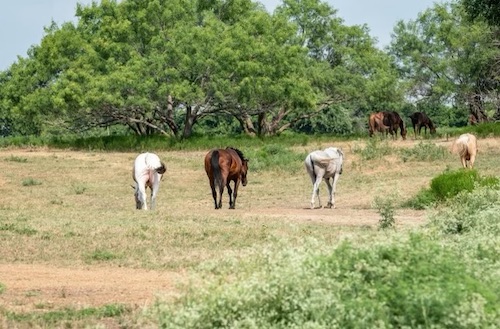 Shade: At 4Hearts, we do night turnout, offer plenty of shady pasture areas, and our horses spend the hottest parts of the day in their stalls under fans
Shade: At 4Hearts, we do night turnout, offer plenty of shady pasture areas, and our horses spend the hottest parts of the day in their stalls under fans
Hydration: unlimited access to fresh, clean water is essential to hot weather health. Hot temperatures can make bucket water turn hot and sour fast. While we have automatic waterers in every stall and pasture to keep plenty of fresh, clean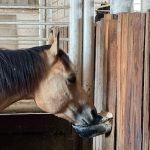 water available at all times (our horses love those shallow, continuously refilling basins of cool water in their stalls — it’s both entertainment and hydration!), if you’re using buckets, be sure to hang at least two — and dump, rinse, and refill them several times throughout the day.
water available at all times (our horses love those shallow, continuously refilling basins of cool water in their stalls — it’s both entertainment and hydration!), if you’re using buckets, be sure to hang at least two — and dump, rinse, and refill them several times throughout the day.
Salt: Offer free access to salt (white or Himalayan pink blocks) helps — and if you’re worried they’re not getting enough, add two tablespoons of loose white table salt to feed.
Limited activity: when both temperature and humidity are up. Many embrace the old “130 rule” (temp + humidity > 130 = don’t ride) as a good rule of thumb, but it also depends on the age, condition, and health of the horse.
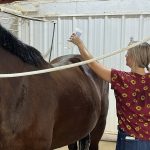 Late afternoon rinses: soak the horse to the skin, all over, with cool water, and then pour 70% isopropyl alcohol down the spine and rub some liniment on the legs to help bring down built-up body heat.
Late afternoon rinses: soak the horse to the skin, all over, with cool water, and then pour 70% isopropyl alcohol down the spine and rub some liniment on the legs to help bring down built-up body heat.
Body clipping: if your horse didn’t shed out completely, has Cushing’s disease, or has always been a hairy yak like mine, getting the extra hair off will help all the other cooling measures you’re taking work better.
I’m happy to report that the distressed mare I discovered in my mid-day barn sweep is doing much better. And she sure is delighted to see me or my assistant coming in every afternoon to provide her spa treatment!
I am also happy to take a moment (in the AC) to share this information with you, hoping it will help you and your horses endure this last (furnace) blast of summer. Before too much longer, we’ll be riding into some of Texas’ most beautiful days—and another spectacular fall at 4Hearts Ranch! Stay cool!
